#Salicornia Salt
Explore tagged Tumblr posts
Text
Salicornia Demonstrates Unique Adaptations To High Salinity Environments
Key Takeaways Salicornia plants demonstrate unique adaptations to high salinity environments, offering valuable insights into salinity tolerance. Genome sequencing of two Salicornia species has been conducted alongside transcriptomic and proteomic analyses of Salicornia bigelovii. The SbiSOS1 protein, a homolog of SALT-OVERLY-SENSITIVE 1, localizes to the tonoplast and pumps Na+ into the…

View On WordPress
0 notes
Text
#2192 - Salicornia quinqueflora - Beaded Samphire


AKA Sarcocornia quinqueflora, bead weed, beaded glasswort, ureure in New Zealand or simply glasswort. The genus are also called Pickleweeds.
A succulent halophyte found wetter coastal areas of Australia and New Zealand, although it's not native to the latter. Oddly enough it's also found in two places in Central Otago in New Zealand, which is nowhere near the coast, but did use to have extensive salt pan habitat.
Historically, people used to burn glassworts to collect the ashes, for the soda content which was used to make soap and glass. It's also edible and the newer shoots quite palatable. Certainly the orange-bellied parrot (Neophema chrysogaster) thinks so - the seeds are a critical food, so the ongoing loss of samphire flats is a disaster for the 180 remaining birds.
Mascot, Sydney, New South Wales
1 note
·
View note
Text
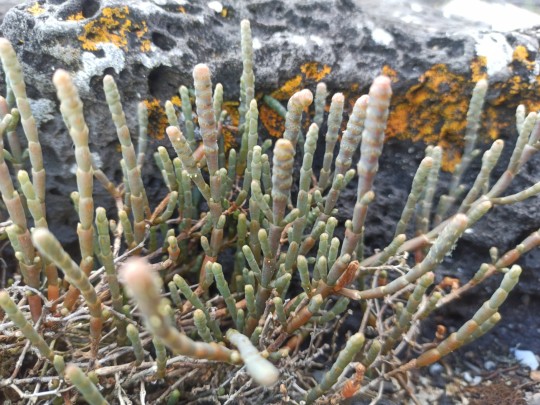
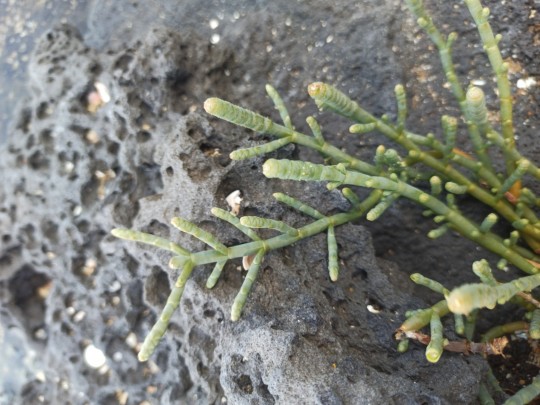
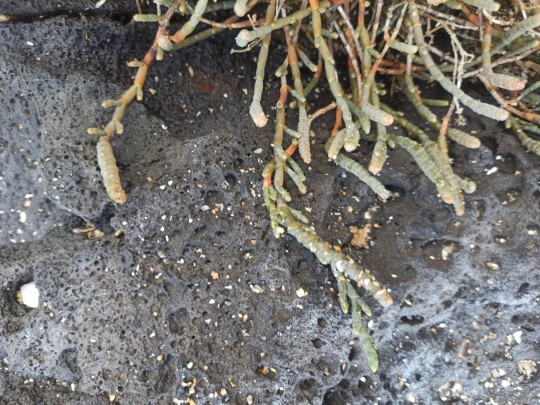
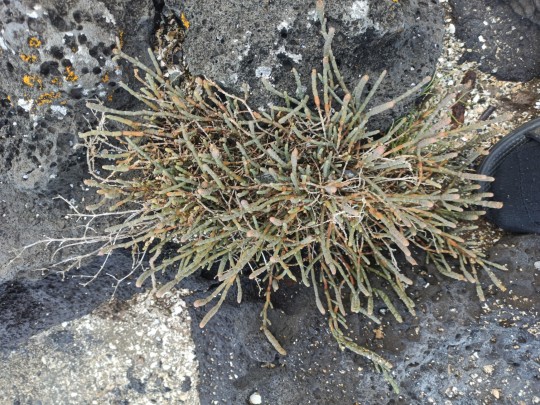
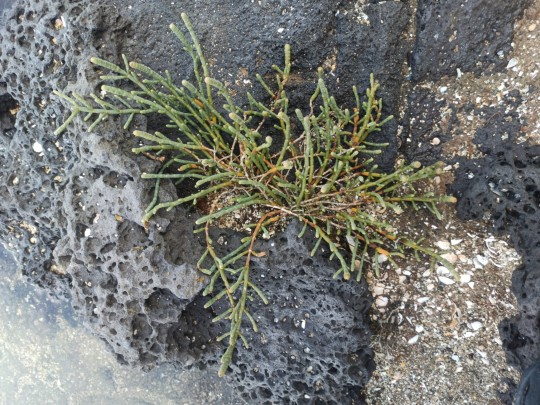

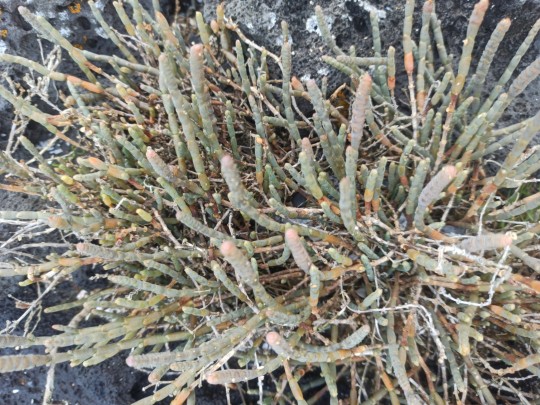

Salicornia quinqueflora, synonym Sarcocornia quinqueflora, commonly known as beaded samphire, bead weed, beaded glasswort or glasswort, Бусинная стеклодувная, The Maori name is ureure, is a species of succulent halophytic coastal shrub.
Clade:Eudicots
Order:Caryophyllales
Family:Amaranthaceae
Genus:Salicornia
Historically, people used to burn glassworts to collect the ashes. The ashes contained a high amount of soda in them, which was used to make soap and glass. This is thought to be how glasswort received its name. salt tolerant plant. It occurs in wetter coastal areas of Australia and New Zealand.
Листья выглядят как крошечные лопасти, обвитые вокруг стебля.
Стеклянница съедобна и вкусна, поэтому, как известно, употреблялась как животными, так и людьми. Рекомендуется есть свежие, молодые, верхние части стеблей сырыми, так как они нежные и более ароматные. Люди могут есть в салате, также можно использовать в качестве гарнира с морепродуктами, хорошо в супах или тушеным для дополнительного вкуса или может быть подано в качестве горячего овоща, можно мариновать.
Он богат витаминами С, А и комплекса В, а также был описан как помогающий метеоризму и пищеварению, был упомянут, как возможное средство для лечения рака.
Te Araroa Trail, Auckland 0622, 6QFG+2GH Auckland
-36.7774360, 174.7763470
наземные цветковые растения травы съедобные прибрежные
0 notes
Text
*thinking for a moment before proceeding to tell Dr. Worm for forty minutes about how salt marshes have zonation based on salt-tolerance in the different plants that grow there and the different varieties of Salicornia spp. and Spartina spp. with a small tangent to talk about mudlarking (which seems to be another hobby) before getting back on track to the various ways plants deal with excess salt, water conservation, low oxygen, and strong tides in a salt marsh in a soft, gentle, low voice meant to encourage sleeping and rubbing the back of Dr. Worm's hand the entire time*
((@twowigglyworms ))
*going to check on their humans during their mid-shift break*
*pulling Dr. Worm's letters out of their apron and opening the green wax sealed one first before the blue wax sealed one*
#dr worm (esc)#(( TJ: I can stay for a little while [40 mins later] and that is how salt marsh plants survive and thrive in salt marshes))
100 notes
·
View notes
Photo
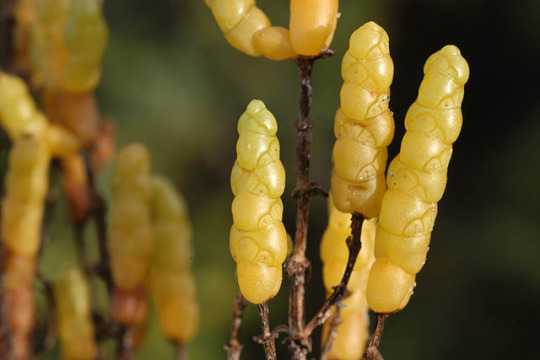
Salicornia brachiata
Umari Keerai
(via)
#Salicornia brachiata#Salicornia#succulent#halophyte#salt water plant#Umari Keerai#yellow#extremophile#edible#salty
72 notes
·
View notes
Text
I love you salt marshes. I love you mudflats and salt pannes, and all the shorebirds that probe for invertebrates beneath your surface, leaving tracks behind. I love you anoxic sulfur-metabolizing bacteria. I love you Spartina patens, and a thundering dark sky against your windswept plain. I love you fish nursery habitat and wave energy absorber. I love you saltmarsh sparrows, even as you lose a race against time, and I am grateful to have looked into your eyes and seen unrelenting resilience there, confident you won’t go down without a fight. I love you mummichogs, pushing the limits of salt tolerance. I love you Salicornia, like neon pink Christmas trees. I love you mosquito ditch lines, visible reminders etched into your skin of how we have mistreated you and must do better. I love you, sense of serenity standing alone in your rustling grasses as the tide comes in, for a moment imagining the world as it once was, when you covered the whole coast and kept both land and sea bountiful and safe from harm. I love you, enough to work to restore your honor and dignity. I love you, I love you, I love you, salt marsh.
#wetlands#nature#salt marshes#salt marsh#what we tagging these things as my friends#cause this could be a lot longer and i can do one for every type of wetland just watch#i have many feelings about salt marshes that cannot be encapsulated in a tungle text post#having worked in them for multiple jobs now.#i do get a gnawing feeling that makes me tear up a little when i think about these precious places we've mutilated so badly#mine#anyway dont mind my 3am feelings just go out and do something to help a salt marsh if you can#support conservation biologists like me who dedicate their lives to uphill battles#we have to teach the world or there will be nothing left to teach about.
121 notes
·
View notes
Photo
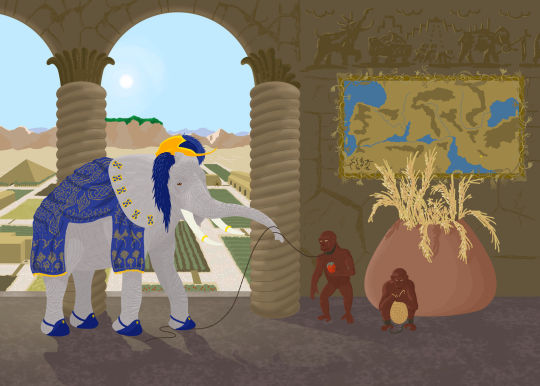
Gods of Salt, or the “““real””” origins of humankind
Might as well post it here directly. (original link, full text under the cut)
« Certainly Nature, when she left the making Of animals like these, did well indeed, By taking such executors from Mars; And if of elephants and whales she doth not Repent her, whosoever looketh subtly More just and more discreet will hold her for it; For where the argument of intellect Is added unto evil will and power, No rampart can the people make against it. » – Inferno, Canto XXXI, 49-57
Consider the following facts:
#1: The Mediterranean Sea loses more water to evaporation than it receives from rivers: it only maintains its level thanks to influx from the Atlantic. Between 6.0 and 5.3 million years ago, in the late Miocene epoch, the closure of the Gibraltar Strait caused the Mediterranean to dry out. This is known as the Messinian Salinity Crisis, and it left vast deposits of gypsum and rock salt. At its apex, this event would have reduced the sea to a few puddles of hypersaline water, similar to today's Dead Sea, surrounded by scorching desert - with temperatures possibly reaching over 40°C due to high pressure. Its islands and peninsulas would have turned to massive mountain ranges up to 5 km tall ([1]). This event ended with the so-called Zanclean Flood, when the Atlantic waters rushed back into the basin, through not one but a series of waterfalls. The overall drop was more than a km, and the discharge of water has been estimated at a thousand time that of the Amazon River ([2]). That's enough to refill the whole Mediterranean in less than 20 years. A sumberged barrier, known as Camarinal Sill, forms the shallowest part of the strait, at only 280 meters below sea level ([3]).
#2: Nevertheless, despite its terrible conditions, the Mediterranean Basin still had enough hospitable land to allow animals to move from Africa to Europe, and vice versa. In fact, the climate, flora, and fauna of Africa and Europe were very similar in the Miocene. Dwarf species of hippopotami and elephants have been found in Cyprus, Crete, Malta, Sicily, Sardinia, the Balearics: all the main islands of the Mediterranean. The lowland-dwellers could have lived along rivers like Po, Rhone, and Nile, which would have cut much deeper valleys.
#3: The Miocene was also a time of great diversity of mammals. In particular, it was the golden age of elephants (which existed in every continent but Australia) and apes (which were even abundant in Europe). European apes included the swamp-dwelling Italian Oreopithecus, 9-7 million years old, which had a pelvis suited for an almost bipedal locomotion ([4]), and hands more capable of precision gripping than those of any living non-human ape ([5]). As for elephants, Primelephas, the likely common ancestor of mammoths and all living elephants, lived in Africa at the end of the Miocene.
#4: Molecular studies place the separation between the lineages of humans and chimpanzees between 7 and 5 million years ago, later than Oreopithecus, and corresponding with the Messinian event. Recent estimates push the divergence backward, even to 10-12 million years ago; however, controversial studies suggest that the two lineages exchanged genes as recently as 4 million years ago ([6]). Clearly the process of separation was more complex than we realized at first, and involved some degree of hybridization between the recent lineages.
#5: The Mediterranean region contains a vast diversity of halophytes, plants than can grow despite high concentrations of salt. Many of these are suitable for human consumption: the oil-rich salicornia (Salicornia sp., eaten both fresh and pickled), the cabbage-like sea kale (Crambe maritima, which grows spontaneously on sandy beaches), the spinach-like sea orach (Atriplex halimus, a close relative of which is grown in India as vegetable and livestock fodder). The argan tree (Argania spinosa) is extremely resistant to both salt and drought, and is prized in Europe and North Africa for its wood and oil. ([7])
#6: The list of Mediterranean halophyte species is actually much wider, but many plants that grow in these conditions are not useful to humans: for example, the Mediterranean beard-grass (Polypogon maritimus), a close relative of oat and wheat, much less nutritious than either. Note, however, that elephants (much more common and diverse in this region in the Miocene) have very low nutritional requirements, and can feed on almost any type of vegetable matter. Now, a key characteristic of the Miocene epoch is a wide spreading of grasslands, replacing the forests that earlier covered most of the globe, triggering a wave of adaptation and diversification among mammals. In fact, between 10 and 5 million years ago, the diet of elephants has switched from leaves to tall grass, a change that can be seen in the shape of their teeth ([8]). Only in the last million years elephants have reverted to eating leaves ([9]).
#7: Until recently, the divergence between humans and chimpanzees had been linked to this event: the ancestors of chimpanzees would have remained in the thick rainforests of West Africa, while humans evolved in the new savannas of the east. This places human evolution entirely in eastern and southern Africa until the last million years or so. This view has been challenged by recent finds. In 2002, the 7-6 million years-old Sahelanthropus tchadensis, a serious contender as common ancestor of humans and chimpanzees, was discovered in Chad, in North Africa. Its foramen magnum suggests an already bipedal pace, as with Oreopithecus ([10]). In 2017, curiously human-like teeth, 7.2 million years old, were attributed to Graecopithecus, in Greece ([11]). Finally, in the same year, 5.6 million years old footprints that clearly show bipedal locomotion were found in Crete ([12]). All of this suggests that the earliest human evolution occurred at first in the Mediterranean region.
#8: The intelligence of elephants is well known. Their brain, over 5 kg heavy, has more cortical gyres than any primate or cetacean, and they might rank in intelligence besides chimps and dolphins ([13]). They form matriarchal herds with extremely strong interindividual bonds and great capacity for cooperation and reciprocal help. They are the only known non-human animals that seem to have ritual behavior related to death ([14]). Pregnant elephants have been observed chewing on leaves of a Boraginacean tree, used to induce labor or miscarriage by Kenyan women ([15]). They can use branches as simple tools, cover water pools to prevent evaporation, and use logs to disable electric fences ([16]). They can recognize themselves in the mirror ([17]), and seem to have artistic inclinations ([18]). Such abilities are especially astonishing in view of such an energy-poor diet. Yet we have seen that their diet was very different in the latest Miocene - that there are plants that grow in the Mediterranean region, could be eaten by ancient elephants, increased in diversity at that time, and are closely related to our food crops.
#9: The elephants' trunk is a dexterous organ of manipulation, capable of handling single seeds and inspecting delicate bodyparts like eyes. Nevertheless, having only one grasping organ could be a handicap for an active tool user (the two fingerlike tips are unique to the African species, and probably didn't exist in Miocene elephants). The trunk can lift loads of hundreds of kilograms, but it's poor at grasping large objects, and can only wrap around them. In comparison, the hands of apes are much more versatile, especially after the innovation we have seen in Oreopithecus. In addition, the same amount of food that sustains an elephant with its single trunk can support not two, but several ape hands - especially since high-energy primate food can pack nourishment in a much smaller mass, even when inedible to elephants. #10: African elephants in reserves readily initiate contact with humans, often forming long-lasting individual bonds, and often prefer to interact with humans than with other animals of their environment. Many of these elephants appear more relaxed and at ease near humans than near even other elephants. This effect has been documented in species with a long history of domestication by humans, such as dogs and horses. ([19]).
Let's place everything together. Six million years ago, near the end of the Miocene epoch, the natural closure of the Gibraltar Strait turned the Mediterranean Sea into a salty desert. The few inhabitable spaces provided a safe passage between Africa and Europe for many species; elephants and apes, which had been increasing in diversity for all the Miocene, were among them.
The depths of the new Mediterranean basin, on the other hand, were a hellish environment that must have forced many species into desperate adaptations. Many plants learned to grow in sand, long before the Sahara became a desert, with concentrations of salt that would kill most others. Elephants, we've seen, are good at finding and storing water, using tools to prevent evaporation from reserves. They must have evolved their characteristic intelligence to deal with the unique challenges of the Mediterranean Basin. Like the Khoisan hunter-gatherers of the Kalahari desert (or for that matter the earliest Homo sapiens) they needed advanced problem-solving skill, good memory, and the ability to cooperate and trust each other. Their eventual solution to ensure themselves a food supply in the great basin was agriculture. Many Mediterranean halophytes are edible even in the seed- and fruit-focused human diet; but the sapient elephants of the Miocene could feed even on simple grass. Cereals like Polypogon - which are, after all, nothing more than especially nutritious grass - must have been a blessing. Perhaps they were even selected artificially to tolerate more saline soils, as could have been the precious argan tree.
Still, the burgeoning elephantine civilization was slowed down by their sluggish reproduction and by their limited capacity for manipulation. The trunk was very effective, but every elephant could only hold one thing at a time. They must have experimented with many forms of animal labor (as well as hydraulic, etc.), but none of the many animals of their region could help them handle objects, make cheap craftwork, or operate machines. Eventually, they started working with apes. Maybe they took a sample of Oreopithecus descendants or Graecopithecus from the northern highlands. They were clever animals, forged by the same cruel environment, capable of understanding gestures and executing simple orders. They wouldn't take away the hard leaves and grass of their masters, but they would eat almost anything else (to the elephants, the ability to digest meat must have seemed extremely precious). They had hands: two hands to grasp a broad object without handles, to scatter seeds on a field, or to hold hammer and chisel in the making of a triumphal arch. So the elephants found themselves ruling over a vast caste of small, nimble, infinitely versatile slaves. Surely they must have tried to enhance them through selective breeding, as humans did with dogs and horses, creating features similar to the short jaws and small teeth of humans, or the peaceful countenance of bonobos. Their genes still bear traces of closely related lineages being interbred. They certainly encouraged a bipedal gait, so that the precious hands remained always free. With ape-servants so common and useful, crawling all around like living robots, elephants must have had little incentive to improve their technology further.
Remember the air at the bottom of the Basin was very thick: it's likely the elephants were specially adapted to breathe it, and would feel much discomfort outside of their cradle. They never ventured beyond what today is the coastline of the Mediterranean, which must have looked like impassable mountains to them. However, they could have sent their servants in exploration on the great islands: leaving, for example, the mysterious footprints of Crete. The proboscidean rulers probably didn't have much more concern for their primate slaves than humans have for cows in a slaughterhouse. Even though they couldn't eat them, they could still fashion their skins and bones into precious objects; sacrifice them to elephantine gods atop of a ziggurat raised by their work; make them fight in blood games or proxy battles; use them for carnal gratification or for medical experiments. The different proclivities of humans, bonobos, and chimpanzees can be understood as specialization for such tasks. We can only wonder what the apes could understand of their condition.
The civilization of elephants had 600,000 years to develop between the Messinian Crisis and the Zanclean Flood: thrice the age of our own species. Certainly they studied in depth their secluded world. As the sea level started to increase on the Gibraltar Strait, they would have probably predicted the danger, and built a massive dam to block the way of the Atlantic waters. Maintaining this dam must have been the highest priority. But there were certainly those who didn't believe this looming danger. And in the end the central sin of the elephantine empire must have caught up to them. What could have distracted the elephants from preserving the Mediterranean Basin as they found it? Probably action from those who had nothing to lose from utter destruction - such as ape-slaves who had finally crossed the threshold of self-awareness. Or rather a preemptive action from those who feared a revolt more than their own annihilation? Some kind of sabotage action, perhaps, that ended a millennia-spanning history by breaking down the great dam, letting the ocean pour into the Basin with an unimaginable catastrophe, and turn it back into a sea.
Some survived, both apes and elephants. They must have been few, perhaps outcasts that had fled, or had been exiled, to the outer highlands. Gradually they accustomed themselves again to the thin air (maybe this didn't even require evolutionary adaptation, just individual assuefaction; but the lords below were used to comfort...). Some were stranded on the new islands, and became the dwarfs of Cyprus, Crete, Sicily. The others scattered into the wilderness of Africa and Europe. Without the infrastructures of the submerged empire, unprepared for the different environment outside, they were unable to rebuilt their civilization. Most of them had been poorly inserted in society, and their intellective faculties weren't the highest, either as a cause or a consequence of their isolation. Alone, they reverted to wild animals, and became gentler than they ever had been when they were civilized beings. They still retain the vestigial skills of artists and doctors; they still mourn the death of their kin. The surviving apes, now free, wandered back into the heart of Africa, passing through Chad. Some found shelter in the jungles of Congo and Nigeria, others in the savannas of Kenya and South Africa, that perhaps reminded them of the flat lands where they were bred into their new shape.
Five million years after that unimaginable disaster, silt has covered all the ruins on the Mediterranean seafloor, and the "domesticated apes" have left Africa in three waves of migration. Now they control the world, from coastlines to mountains, they remake its land into cities and farms, and they hold in their power the fate of the distant descendants of their ancient masters. It remains to be seen whether they will choose to be merciful or vindictive. Aren't five million years enough to expiate any sin?
60 notes
·
View notes
Text
Falathrim World Building Introduction (First Age Prior to the Isle of Balar)
(Noldor, Teleri, Vanyar, Sindar of Doriath)
I did some introductions to world building for the three main cultures of the Eldar in Valinor and the Sindar of Doriath and I want to write more for those but I also wanted to do the other kindreds so here’s part one for my Falathrim World Building
Here are some more general world building headcanons (architecture/homes, governance, etc) Please feel free to ask more!! I’d love to expand on food, environment, flora and fauna, etc
Please feel free to ask more!! General posts are hard because I didn’t have specific categories to cover so feel free to send categories! I also included some similarities and differences with the Teleri in Valinor
The Falathrim lived on the coasts of Western Beleriand where they were persuaded to stay by Ossë. They lived at the Havens of the Falas at the mouths of two rivers, Nenning and Brithon. There were two Havens, Brithombar and Eglarest, walled cities that lasted until the Fifth Battle where the surviving Falathrim moved West to the Isle of Balar
Círdan is considered an authority and leader despite never being officially appointed. The Falathrim of Beleriand do start out with a less formal system of rule than their kin in Valinor. As time goes on a more formal system of governance does emerge with appointed roles. Much is decided communally
The houses and structures were made of sandstone, clay and wood with imported stone from their allies utilized in the reconstruction after damage during the First battle of Beleriand. Tufa and limestone were also used in the walls, towers, and fortification
Sand ryegrass is also used in more temporary homes as well as baskets and nets.
In the Eastern reaches of their land, sheep were kept for wool and thus fabric (as well as milk). They were originally traded for with the Sindar of Mithrim. Flax, nettle and other salt marsh plants are also used in clothing. Shells are used in jewelry and metal production is relatively rare outside weapons.
Clothing is generally made with practical uses being considered first but there is absolutely a distinct fashion among the Falathrim.
Shell and bone are also used for blades. Pearl blades are a particular treasure.
Pearls are highly favored by the Teleri and though prized by the Falathrim, they do not have the same place in their culture. See the differences at the bottom
Several of the archways at Brithonbar contains fossilized ammonites.
Map making, cartography including astrocartograpgy, and navigation are highly valued skills and trades. Ink is made from the berries of a few plants and from pigment made from rock with traces of iron. Quills are typically made from sea bird feathers
Like the Teleri, Falathrim children grow up with a respect and love for the water. Swimming, safety, and knowledge of plants and animals of the water and shores is taught from a very young age. Knot tying and rope and sail making using fibers and cloth is also widely taught. Boats are typically wooden with cloth sails.
Trade began with Nargothrond and their allies soon after the hidden city was constructed though Finrod and his smaller group of followers canonically aided them long before. Routes for travel were known to the Falathrim long before the return of the Noldor.
Fish make up a lot of their dishes along with sea and salt marsh vegetables like Salicornia and sea purslane. Methods of seasoning are similar to Telerin and Iathrim methods and tend to rely on herbal sauces and garnishes rather than spices. Shrimp and crab are eaten far more commonly than the Teleri.
Olives grow to the North and South of the Havens and are cultivated in groves along with lemons closer to Nevrast and orchard stone fruit South of Egalrest. White peaches are rarer and often traded from East of the Havens but are a favored treat.
Some primary differences with the Teleri of Valinor
Teleri: sheer fabrics primarily from traded silk and very light cotton flower, large communal homes, pearlescence, music and instrument making, elaborate gardens and water scapes
Falathrim: primarily linen from flax, common use of sand ryegrass, silver and pale metallic colors, smaller often temporary homes, cartography, epic poetry, more practical gardens, fossils
Similarities: limestone and sandstone architecture, similar community governance ideas (though Alqualondë has a king of course), herbal sauces and garnishes
32 notes
·
View notes
Text
Sea Beans
Given the extortionate and rising cost of fresh vegetables in the few grocery stores we have found during these last few months in the Bahamas, we’ve been keen to expand our foraging repertoire. Sea beans, otherwise known as sea asparagus and pickleweed, belong to the genus Salicornia, marsh plants that thrive in salty areas such as the salt ponds found on island in the Bahamas, as well as…
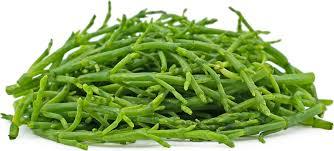
View On WordPress
11 notes
·
View notes
Text
Ocean Empire Crop Calendar
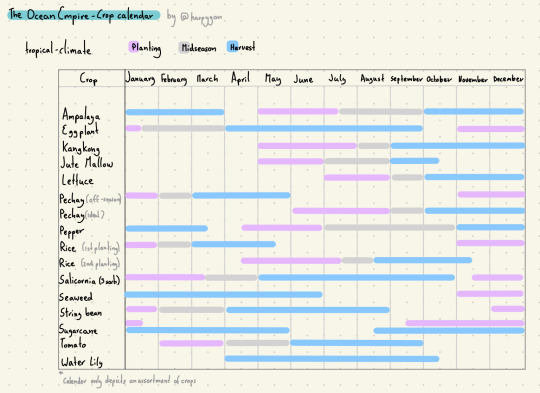
[Grimlands] [House Blossom] [Gilded Helianthia]
detailed thoughts (and information about crops depicted) under the cut
Jute Mallow isalso known as „bitter melon“ „bitter apple“ „bitter squash“ and bcountries specified as lying in the tropical zone (dependent on the list there might be more or less), I chose to look at the south-east Asian countries of Indonesia, Malaysia and the Philippines, the last being my main point of comparison.
The problem with the ocean empire is that it seems to have extremely limited planting ground (not taking into account soil under the ocean), meaning that most crops aren't really plantable.
In the beginning, I thought this was it, the ocean empire would have to live off fish, seafood and seaweed, but then I found hope.
This article talked about salt water rice, and while this example is made through human gene mutation, I'll assume that it naturally exists in the ocean empire.
Furthermore, we see lily pads being used a lot in the ocean empire, which his helpful, as (almost) the entirety of it is edible. Not only that, but the seeds can be ground into flour, meaning we have more options for filling foods such as bread. (There are no regular planting or harvesting seasons, as they just die back to their roots and then regrow later and different harvestable parts get harvested at different points in the year, so I just made a rough estimate based on the flowering time of the lilies) (out of context but one can make silk out of lotus flowers meaning that silk clothing made out of lotus flowers would be worn)
Seaweed itself would be growable almost everywhere where a water height of ca. 6 metres is present, and they are harvestable every 45-60 days (sources differ). The main harvest season spans January June.
Halophytes or salt-loving plants, form another big category of plants that could be planted. There are 3 sorts of halopythes, but we will only focus on Aqua-halines and then the subgroups of Hydro-halophytes (whole or almost whole plant remains under water) and Emerged Halophytes (most of the stem remains above the water level).
Most plants with the prefix „sea“ don‘t actually grow in the sea, as I sadly had to learn. But they are more salt tolerant than other plants which is why I will include some of them.
One of the best known ones is Salicornia. Salicornia europaea (underwater asparagus or sea pickles) is completely edible raw and cooked. Salicornia bigelovii is an oil crop, reaching about 60cm In height. Salicornia brachiata can be made into a culinary salt (substitute). They grow year round, but are planted in the “colder“ months of the year, meaning the cold dry period between December/November and February/March.
Now I thought the crop calendar looked pretty sad wit’s just those few plants, so I looked at foods commonly grown in The Philippines and picked some examples as things that could be grown on the little overwater soil they have.
I believe that on the shorelines of the little land they do have, people would plant sugarcane. It can be used as both a sweetener and just an ingredient for normal cooking. The harvest and planting seasons do overlap, which is why the crop calendar shows two rows instead of one.
Ampalaya, also known as „bitter melon“ „bitter apple“ „bitter squash“ and “balsam pear“ is a vine that produces a fruit, that is pretty bitter. It takes between 80 and 120 days to grow (differs based on sunlight sensitivity)
Kangkong or “water spinach“ is a form of spinach. It grows extremely quickly (just thirty days) and starts flowering in October. It is technically plantable year round, but as the seeds only mature by end of April and the plants are uprooted at the end of harvesting season, I assumed that they could only be planted after April (this could of course be altered by saving seeds or planting Kangkong off season)
Jute Mallow is a leafy plant with a slimy texture (similair to that of okra).
Pechay or „Chinese cabbbage“ is a cabbage. It has two main harvest seasons, one set in the “ideal“ season meaning the hot wet season and one in the cold dry off season.
String beans are a type of green bean.
Conclusion: The majority of the Ocean‘s empires cuisine would be based around rice, seaweed, various halophytes, and water lilies. However, the little overwater soil they do have allows for them to have a wide selection of vegetables, fruits and spices.
19 notes
·
View notes
Photo
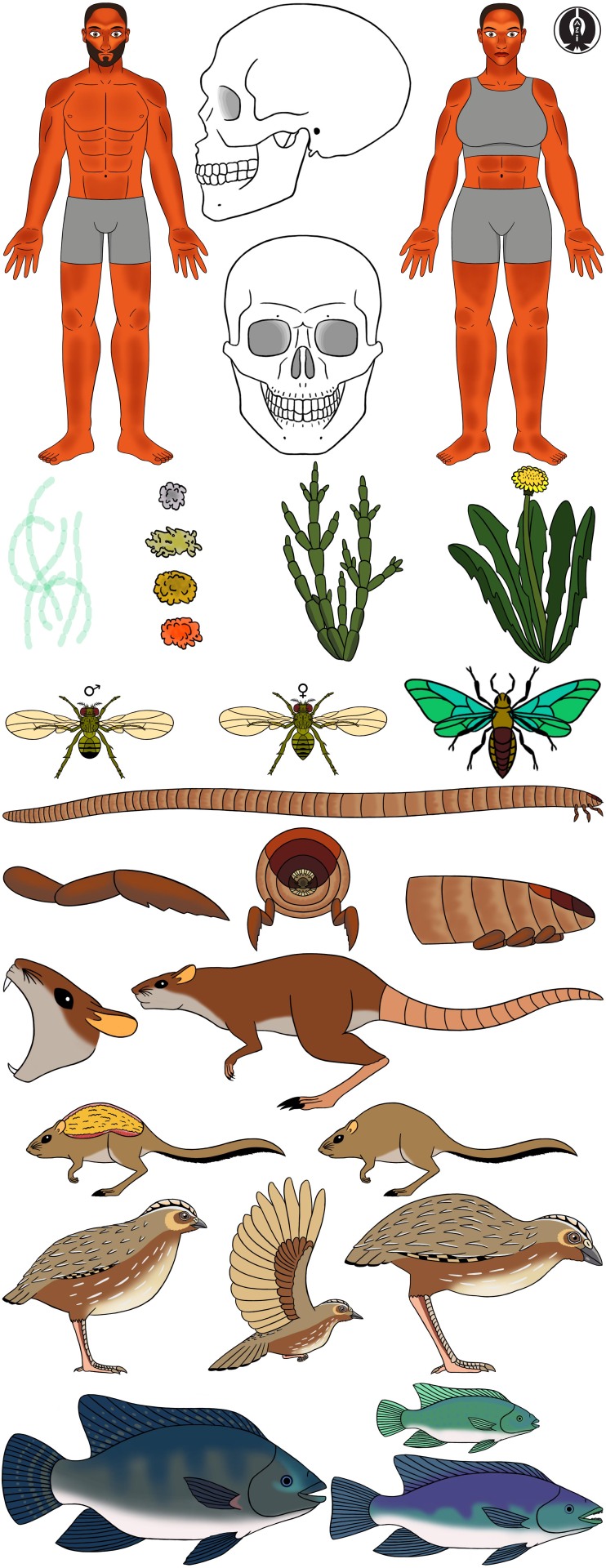
Took a while but I finally finished this piece showcasing Martian humans and the lifeforms that inhabit a terraformed Mars within the story of Centauri. There’s a lot of things here so I’ll be brief and to the point. The first permanent colonists of Mars would have undergone genetic editing to receive traits that ensure survival. These include tolerating lower oxygen and air pressure (a mutation Tibetan populations possess today), higher radiation resistance, and higher muscle and bone density to counteract Mar’s lower gravity. By roughly 3045, Martians humans became physically and genetically distinct. The best analogy would be orange neanderthals with chins, larger eyes (due to Mars receiving less sunlight), and stretched up to 2m in height on average. Next is photosynthetic lifeforms. Algae and photosynthetic bacteria make up the bulk of this category being the first organisms intentionally introduced. They were later joined by hearty lichens and eventually more complex plants such as dandelions and Salicornia (aka sea asparagus). The plants differ from their Earth counterparts by being darker green and significantly taller with the dandelions evolving a willowy structure due to the frequent Martian winds. Fruit flies were initially brought as the first lab animals for scientific studies such as the effect of Mars’ conditions on their development and evolution. Eventually they were released to help establish an ecosystem, evolving to feed on the surplus of algae and bacteria that border the newly formed rivers, lakes, and oceans. Non-hiving bees were brought to Mars to pollinate the food crops the Martian Colonists depend on, being released when flowering plants started gaining a foothold in the environment. Both insect species grew larger due to less gravity and evolved proportionally larger wings due to lower air pressure making flight more difficult. Unlike other species inhabiting Mars, the sand worms are a product of genetic engineering with their base being earthworms and Zophobas Morio (aka super worms). Designed to swim through sand and burrow through hard ground, the sand worms were giving bacteria in their gut to break down the toxic perchlorate salts within the martian soil they ingest. The byproducts are oxygen, which the worms use for respiration, and chlorine, which the worms excrete as solids that can be utilized by Martian colonists, mainly to create greenhouse gases to maintain Mars' atmosphere. This process also makes the soil more palatable for plant life. The combination of lower gravity constraints and the extra oxygen gained from their feeding process allows the sand worms to grow to exceptionally large sizes; up to 6.71m (22ft) long with a 12.2cm (4.8in) diameter. Just like the fruit flies, rats and mice were initially brought as lab animals before being release to establish an ecosystem. Though only 300 years had past since their release, speciation has already occurred and the two shown are only the most prominent. Both rodents adopted hopping as their means of locomotion as a result of the lower gravity but evolved significantly different ecological roles. The rats became predators with the currently largest species reaching up to a meter (3.3ft) long. The mice maintained the role of herbivores with the most unique species to date being the hunched-backed mouse. This species has extra layers of fat on it's back that serve several purposes; storing extra nutrients, insulation from Mar's cooler environment, and extra weight to counteract the lower gravity. Quails were one of the last species to be brought to Mars and done so as a protein source that grew fast and was low maintenance. Though some were intentionally released, a domesticated population that is heavier and more meaty than their ancestors still exist within the Martian colonies. The released quails so far evolved into two main species; an small, insectivorous flyer with proportionally large wings and a larger herbivore with a thicker beak for grinding plant material. Tilapia were actually the first animals brought to Mars by humans, though limited to aquaculture within the settlements. These were a variation of the blue tilapia which could tolerate colder and brackish water. Once significant bodies of freshwater formed and the atmosphere became more hospitable, they were released into the Environment. With no competition or predators, the tilapia population were able to diversify within a relatively short time, even evolving into predators and oceanic species.
As always comments and critiques are welcome.
Also, if you like my art, please consider supporting me on Kofi: https://ko-fi.com/aut2imagineart
#Mars#martian#speculative evolution#speculative biology#speculative zoology#rats#worm#sand worms#fruit fly#bee#dandelion#plants#animals#human evolution#posthuman#genetically modified#terraform#creature design#my art#digital art#digital color#Digital Illustration#quail#japanese quail#tilapia#fish#future evolution
24 notes
·
View notes
Photo

It is exiting to find wild edible plants in different areas. A lot of salicornia (samphire) here, on salt flats or sea cliffs. The salty taste is great but I am not sure we are digesting it well. Not yet, anyway. I sympathise carnivore people because they go against the official narrative and they have a point, arguing that plants mostly do not want to be eaten, but don't think I will abandon all vegetable stuff any time soon: I felt really weird last time I tried. And I know that most people, at least during recorded history, have been eating plants and using many of them for medicines. People did lived long lives and stayed healthy on plant foods too. I am not a nutritionist. Because the professionals just can't agree on an optimal diet, I think the most important thing is for us to learn listening to our bodies while adding or eliminating foods. Variety should help with getting plenty of vitamins and minerals. Also it's very important to learn to change the diet or to go without food from time to time, to gain more freedom and independence from the variety of circumstances in one's life. This is the difficult part for me as I am the one doing cooking most of the time at home. Telling myself that "this is a path to more freedom" should help, theoretically... #food #wildfood #foraging #salicornia #samphire #Mediterranean #herbs #diet #thoughts #justthinking #freedom #independence #lifestyle #travel #adventurethatislife #linandara #escape #nft #curiosities #linandaras_art #art #arte #feeltheforce #artcollection #artwork #innerwork #рисунок #wanderlust #sigil #странныйрисунок (hier: Mediterranean) https://www.instagram.com/p/CVvq8JvoDVi/?utm_medium=tumblr
#food#wildfood#foraging#salicornia#samphire#mediterranean#herbs#diet#thoughts#justthinking#freedom#independence#lifestyle#travel#adventurethatislife#linandara#escape#nft#curiosities#linandaras_art#art#arte#feeltheforce#artcollection#artwork#innerwork#рисунок#wanderlust#sigil#странныйрисунок
5 notes
·
View notes
Text
Iris Publishers
Use of Salt-Tolerant Plants and Halophytes as Potential Crops in Saline Soils in China
Authored by Faisal M El Hag

Introduction
As one of the major abiotic stresses, salinity severely inhibits plant growth and development, leads to crop yield loss and plant ecosystem deterioration worldwide [1,2]. Sodium chloride is considered to be the most component that causing salinization and is the widespread salt that existing in saline soils [3]. UP to now, almost 10% of the land area and 50% of the irrigated soils area was affected by salinity presence [1,4]. In addition, the degree of soil salinization is still intensified due to natural and human factors such as irrational irrigation. Simultaneously, the agricultural land has declined due to the industrialization, the urban development, and the habitat need with the rapid increase of population [5]. Therefore, developing strategies to make use of saline land will be crucial for addressing the problem of insufficient farmland and meeting the challenge of providing food security for the projected global population of 9.3 billion people by 2050. It is considered as a desirable and sustainable strategy to plant the salt-tolerant crop varieties and halophytes for the agricultural usage of saline soils.
In general, the growth and the reproduction of crops were severely inhibited when they grow in saline environments [6], even died in heavily saline soils. 99.13 million hectares of saline-alkali land are present in China, accounting for about 12% of the world’s saline-alkali land, and more than 20 million hectares of land are considered to be saline, among which 20% are distributed in cultivated lands [7]. Many works have been done in getting a better and more efficient way to use of the salinized land by biological methods in China. In the present paper, applied and potential plants that could grow on saline land and with economic and application value will be discussed, which will provide an insight understanding and application reference for improving and using the saline soils for agriculture.
Discussion
There are about 420 halophyte species and more than 1000 salt-tolerant plants in China. In the current, a wide range of applications could be implemented according to the salt-tolerant plants and halophytes. Up to now, more than 100 species of the salt-tolerant plants and halophytes have been applied for improving saline lands in China. They could be used as food, such as the salt-tolerant wheat (Dekang 961, Shanrong 3), quiona, and sorghum; vegetables, such as Suaeda salsa, Salicornia bigelovii, and Ice plant (Mesembryanthemum crystalinum L.); forage, such as Atriplex triangularis, sweet sorghum, and wild soybean (Glycine soja Sieb. et Zucc.); fruits, such as winter jujube (Ziziphus jujuba cv. Dongzao), and Nitraria tangutorum; medicine, such as Glycyrrhiza uralensis Fisch, Apocynum venetum, and flower plant such as Limonium sinense. And bioenergy is considered as a renewable new energy.
With the rapid economy expansion, the demand for energy is sustaining insatiable. Bioenergy such as ethanol is selected as a new alternative energy source to meet the global requirement. In addition, to avoid the completion of food and farmland for people in China, the bioenergy is allowed to produce only in marginal soils such as saline soils by culturing the energy crops with higher salt-tolerant ability such as sweet sorghum, hybrid pennisetum, Manihot esculenta, and sugar beet [8,9,10]. Sweet sorghum with high salt tolerance, photosynthesis, high biomass and sugar content in the stem is widely planted in saline soil to be a suitable crop to produce the food, the animal feed, good liquor-making raw materials and bioethanol [11,12].
Halophytes could grow under extreme salt conditions with highly salt-tolerant ability, evenly at sea salt level [13]. As the precious plant resources with high applicable value, halophytes have been obtained more and more attentions by scientists [14]. For instance, to remediate the saline soils by culturing halophytes, preventing salt back to the soil surface, and removing salt from the soils that reducing salt content [5]. In addition, halophytes also have many economic values, for example, some of them could be used as vegetables, fodder and fruit [15,16]. Even some of the halophytic vegetables such as Suaeda salsa could be irrigated using seawater or grown in the intertidal zone [17]. It could be providing gourmet vegetables using seawater and meet the shortage of freshwater resources in the world [18]. Furthermore, halophytes have other usage, Suaeda salsa could be used to produce oil due to the abounded content of unsaturated fatty acid in their seeds [19,20]. Halophytes could provide abounded salt-tolerant genes for studying the salt tolerance mechanism and obtain the genetically modified salt-tolerant crops. Perhaps, the problem of “less land for more population” in the developing countries could be solved by planting salt-tolerant plants and halophyte on the saline soils and provide economic benefit and could meet the problem of the restricted agricultural land resources [21,22].
Conclusion
With the increasing of the saline areas and the degrading of the arable soils in the world, we face the problem of how to balance the reducing of farmland and the increasing of the requirement of food and energy. The growth, development and reproduction of all crops are severely inhibited by saline soils. While some of the salt-tolerant plants can grow in the saline conditions, which could utilize the saline soils by culturing salt-tolerant plants and provide us food, vegetables, fruits, animal forage, flowers and bioenergy. This will solve the contradiction between the increase in population and the decrease in cultivated land area, and at the same time, provide a better method to develop and utilize of saline land. Therefore, screening more salt-tolerant plant and halophytes with high potential value in agriculture is an urgent task
To read more about this article: https://irispublishers.com/wjass/fulltext/use-of-salt-tolerant-plants-and-halophytes-as-potential-crops-in-saline-soils-in-china.ID.000606.php
Indexing List of Iris Publishers: https://medium.com/@irispublishers/what-is-the-indexing-list-of-iris-publishers-4ace353e4eee
Iris publishers google scholar citations: https://scholar.google.co.in/scholar?hl=en&as_sdt=0%2C5&q=irispublishers&btnG=
1 note
·
View note
Note
Any Fodlan AUs?
Nightmare in the Kitchen AU
Gordon goes to the monastery - it’s a big restaurant where young trainees and apprentices come from all around the world to become chiefs
But suddenly its reputation started to decline.
Trainee Dimitri insists on cooking even if he cannot taste. As a result, he doesn’t understand when someone tells him that no, random weeds and Salicornia can’t be swapped. He cooks a lot for the charities activites of the monastery, basically giving food to homeless people and orphans, but since most of it is, at best, bland, he doesn’t meet a lot of success.
Trainee Edel pushes for Adrestian cuisine calling other types of cuisine offshoots but at the same time she despises the star system, a chef can be a good chef even if they don’t have any stars, right? Her second, often threatens anyone who eats her food to give her praises, so actually, she doesn’t know if people genuinely enjoy her dishes or if they’re afraid of Hubert.
Trainee Claude’s most likely curious and loves to mix and match ingredients you don’t put harissa in your sauerkraut ffs!) that shouldn’t be, but uses a lot of olive oil everywhere, hinting that he is familiar with a certain type of cuisine but won’t reveal anything. For some strange reasons, his dishes aren’t horrible, but they never match with what’s written on the menu.
Gordon tries to reason them a bit and ask them to follow the menu and make a Garreg Mach Pie, Dimitri messed with the salt, Edel refused to use Faerghus Cheese and used instead Adrestian Parmesan Cheese with awful results, it doesn’t have the same texture and taste, and Claude made a destructured Pie swapping potatoes with lentils.
Gordon meets Seteth and they both freak out because at this rate, the restaurant is going to close.
Rhea asks them to have faith in the students, and watches with interest a promising young chief, Billy, whose meals are really bland. As a result everyone eats them, but they’re not returning to the restaurant because you don’t pay to eat something that’s not specially good or bad.
Manuela, who’s in charge of the wine cellar, suggests he take a drink, but when Gordon notices Manuela’s drinking the reserves and bottles meant for the customers, he immediately refuses.
At the end of the week, he gives up and returns home.
#Fodlan nonsense#anon#replies#Fodlan au#Claude is trying to push for fusion food but he uses all of the weird associations#Edel's trying to milit for the end of elitist cuisine and gastronomy#and Dimitri has a lot of good feelings but without his trusted second his feelings aren't translated in his dishes#but he's totally the kind of person to make :) cupcakes for the children#and then they're tasteless so the children only eat the glazing but not the cake#Billy's special power is to make everything bland#they cater to everyone's tastes!
2 notes
·
View notes